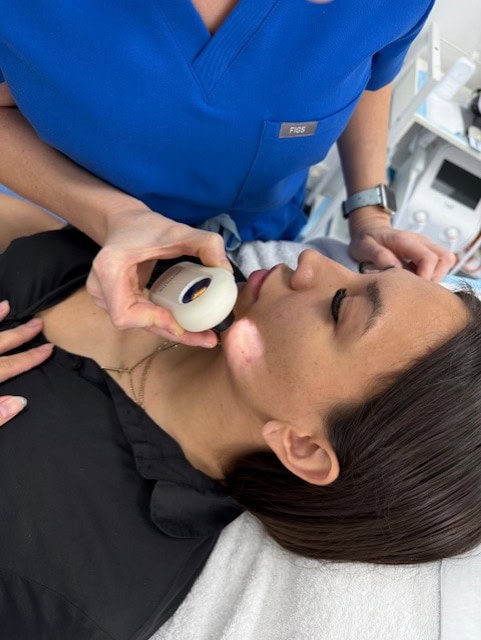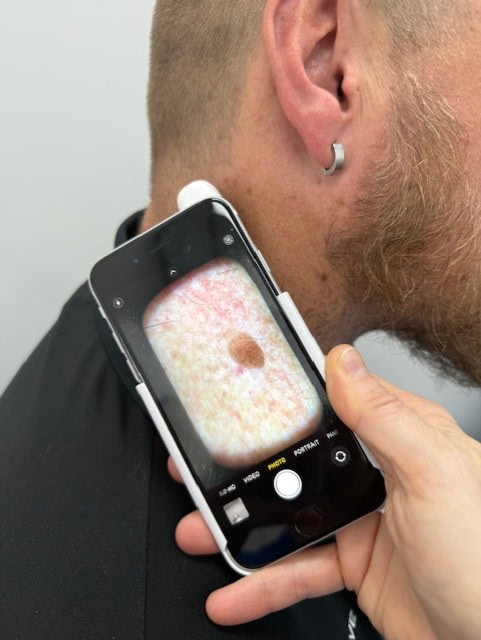
What to expect
- Please don’t wear any make-up, nail varnish or tanning products
- Unless attending for a specific lesion/spot of concern, a full skin check is recommended
- When the Clinician calls you into the consultation room she will ask you some questions regarding family history, previous excisions, occupation, level of sun exposure and frequency of sun protection
- Your Clinician will ask you to undress to your underwear
- Your Clinician will ask you if you have any spots of concern including beneath your underwear
- Your Clinician will begin a systematic approach using a Clinician to cover all parts, paying particular attention to spots of concern and sun exposed areas
- Your Clinician may lightly palpate each lesion for additional clues
- Some procedures may be undertaking during your consultation :
- Cryotherapy (freezing of a skin spot using liquid nitrogen)
- Laser
- Before giving consent to these procedures, you should understand:
- What the procedure is
- Why it is being done
- What is involved in the healing process
- Potential side effects
- Cost
Results
All results are given in a skin check report document and with images, and are recorded and kept in DERMENGINE- a software used by many skin cancer clinics.
*Please note, Cosmedispa is a specialised Skin Screening Service and NOT a bulk billing GP practice.

What happens if the clinician finds anything which could be skin cancer?
Your clinician will tell you straight away if you have any moles or spots which require testing and our skin doctors will test you on the spot. A biopsy (sample) of it, or completely excise (cut out) the spot of concern – under local anaesthetic of course. In most cases another appointment will be made to remove the abnormal mole or spot. This type of minor surgery can be carried out at your doctor’s surgery or office. There is usually no need for this to be done in a hospital.
After it is removed, the mole or spot is sent to a pathology laboratory for testing. Receiving the test results can take from one to several days, depending on the pathology provider.
What happens if skin cancer is found?
You will be immediately referred to a Skin Doctor Specialist. In most cases, when found early, skin cancer can be easily and successfully treated with surgery from a specialist. Most skin cancers are cured once they are removed. Other non-surgical treatments such as creams, radiotherapy, or light therapy may be used but this will depend on the type of skin cancer found.

What happens after the skin check?
Depending on your level of risk for developing skin cancer, your clinician may recommend regular follow-up skin checks. The frequency for follow-up skin checks can vary from every few months, to once every year or two. Most clinicians will have a system in place to send you a skin check reminder, but it is also a good idea to keep your own record of when a follow-up skin check is due.
The accredited Dermoscopist at cosmedispa is dedicated to the prevention, diagnosis and treatment of all benign lesions and referral of malignant or suspicious lesions. We offer local, cost-effective access to advanced knowledge, diagnostic techniques, and treatment. You, however, are the person most familiar with your skin, so SCAN thoroughly and repeat often. It’s a simple habit to get into, and one that might save your life.
How long does a skin check take?
A thorough skin check can take from 20 mins up to 30 minutes (depending on the number of moles/ Lesions). This includes some time for the doctor to discuss your medical history – which can have an impact on your risk of developing skin cancer.
What equipment does the clinician use?
At Cosmedispa Oxendord, our accredited Dermoscopist has been trained to use a dermatoscope and will take a close up look at any spots of concern to assist in a diagnosis. A dermatoscope is a bit like a torch with a magnifying glass attached to the end. Using a dermatoscope is painless, and greatly assists the doctor in deciding if a spot or mole is, or is not of concern. If uncertain, the doctor may take a dermoscopic photograph of a spot or mole, so it can be monitored over time for any changes.
Level 1
- Comprehensive skin check
- 30 mins $120
- Full body (excluding genitals)
Level 2
- Visible areas skin check
- 15 mins $80
Level 3
- up to 3 lesions
- Spot check $50
*All levels include images, skin check report & referral if needed.
